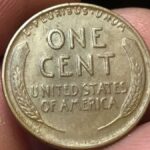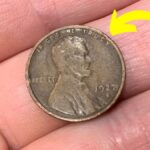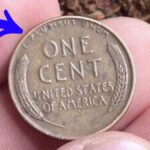The Lincoln Wheat Penny Valued at $425K: The Lincoln Wheat Penny holds a special place in American numismatic history. While most of these small copper coins are worth exactly one cent, certain rare specimens have sold for staggering amounts—some fetching as much as $425,000 at auction. This remarkable difference in value has sparked treasure hunts in coin collections, piggy banks, and even pocket change across the country.
The Birth of an American Icon
First introduced in 1909 to commemorate Abraham Lincoln’s 100th birth anniversary, the Lincoln Wheat Penny represented a significant shift in American coinage. Designed by sculptor Victor David Brenner, it became the first U.S. coin to feature the portrait of an American president. The penny’s distinctive design features Lincoln’s profile on the front (obverse) while the reverse displays two wheat stalks framing the words “ONE CENT” and “UNITED STATES OF AMERICA.” This design remained in production until 1958, when it was replaced with the Lincoln Memorial design.
The Most Valuable Lincoln Wheat Penny Varieties
Among the billions of Lincoln Wheat Pennies produced over nearly five decades, a few rare varieties stand out for their exceptional value. The 1943 Copper Penny is perhaps the most famous and valuable of all. During World War II, the U.S. Mint switched from copper to zinc-coated steel for penny production to conserve copper for the war effort. However, a small number of copper planchets (coin blanks) from 1942 accidentally remained in the presses and were struck with the 1943 date.
These 1943 copper pennies are incredibly rare, with fewer than 20 known to exist. Due to their scarcity and the fascinating historical error they represent, these coins have sold for more than $425,000 at auction. Authenticating a genuine 1943 copper penny involves several tests—it should weigh approximately 3.11 grams (compared to 2.7 grams for the steel version) and, unlike the magnetic steel pennies from that year, a copper penny will not stick to a magnet.
Another highly valuable variety is the 1909-S VDB penny. This was among the first Lincoln pennies ever produced and bears the “S” mint mark (indicating it was made at the San Francisco Mint) along with the designer’s initials “VDB” on the reverse. Only 484,000 of these were minted before public criticism led to the removal of the initials, making this coin extremely rare. Depending on its condition, a 1909-S VDB penny can be worth between $1,500 and several hundred thousand dollars for specimens in pristine condition.
The 1955 Double Die Penny represents another valuable error coin. During minting, the die that stamps the design onto blank coins was accidentally impressed twice at slightly different angles, creating a noticeable doubling effect on the date and lettering. With only around 24,000 of these error coins released, a mint condition specimen can be worth up to $425,000 today.
How Minting Errors Create Value
Errors during the minting process often result in coins of exceptional value to collectors. The 1944 Steel Penny exemplifies this principle. While most 1944 pennies returned to the standard copper composition after the wartime steel experiment, a few were mistakenly struck on leftover steel planchets from 1943. With fewer than 30 in existence, these rare error coins have sold for between $100,000 and $425,000 at recent auctions.
These minting mistakes, combined with historical significance and extreme rarity, create the perfect conditions for extraordinary valuation. While deliberate errors are impossible in modern computerized minting facilities, these historical anomalies serve as fascinating windows into the minting processes of the past.
Identifying a Potentially Valuable Wheat Penny
For those hoping to discover a valuable Lincoln Wheat Penny in their collection, certain key features should be examined. First, check the date and mint mark—the most valuable dates include 1909-S, 1914-D, 1922 (with no “D” mint mark), 1943 (copper version), and 1955 (double die variety). The mint mark, if present, appears under the date on the obverse side.
Next, carefully examine the coin for errors or unusual features. Using a magnifying glass, look for doubling in the letters and numbers, off-center strikes, or misprints. For 1943 pennies, weighing the coin and testing it with a magnet can help determine if it’s the valuable copper version rather than the common steel variant.
If you believe you have a rare specimen, professional authentication is essential. Reputable grading services like the Professional Coin Grading Service (PCGS) or Numismatic Guaranty Corporation (NGC) can verify authenticity and assign a grade that significantly affects the coin’s value. Having a coin professionally graded also makes it more marketable to serious collectors.
Where to Sell a Valuable Lincoln Wheat Penny
Those fortunate enough to possess a rare Lincoln Wheat Penny have several options for selling it. Specialized auction houses like Heritage Auctions, Stack’s Bowers Galleries, or GreatCollections regularly feature rare coins and can attract serious collectors willing to pay premium prices. Online marketplaces provide another avenue, though care should be taken to ensure secure transactions and proper valuation.
Established coin shops and dealers represent another option, particularly those specializing in rare and valuable coins. These professionals can often provide immediate offers, though the price might be lower than what might be realized at auction to account for their overhead and profit margin.
The Enduring Appeal of Wheat Penny Collecting
The possibility of finding an extremely valuable coin among everyday currency continues to fuel interest in coin collecting. While the chances of discovering a $425,000 penny are admittedly slim, the hunt itself has educational value and has introduced many people to the fascinating hobby of numismatics.
Beyond potential monetary value, these coins connect us with American history, offering tangible links to the past. Each penny potentially passed through thousands of hands during some of the most transformative periods in U.S. history, from the Great Depression to World War II and beyond. This historical connection adds depth to their appeal that transcends their market value.
For the vast majority of collectors, the thrill of the hunt and the joy of building a collection remains the primary motivation, with the remote possibility of a significant find adding excitement to an already rewarding hobby.





